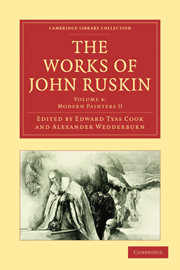Book contents
- Frontmatter
- Contents
- LIST OF ILLUSTRATIONS
- INTRODUCTION TO THIS VOLUME
- BIBLIOGRAPHICAL NOTE
- MODERN PAINTERS
- AUTHOR'S PREFACE TO THE RE-ARRANGED EDITION (1883)
- AUTHOR'S SYNOPSIS OF CONTENTS
- PART III OF IDEAS OF BEAUTY
- SECTION I OF THE THEORETIC FACULTY
- CHAPTER I OF THE RANK AND RELATIONS OF THE THEORETIC FACULTY
- CHAPTER II OF THE THEORETIC FACULTY AS CONCERNED WITH PLEASURES OF SENSE
- CHAPTER III OF ACCURACY AND INACCURACY IN IMPRESSIONS OF SENSE
- CHAPTER IV OF FALSE OPINIONS HELD CONCERNING BEAUTY
- CHAPTER V OF TYPICAL BEAUTY:–FIRST, OF INFINITY, OR THE TYPE OF DIVINE INCOMPREHENSIBILITY
- CHAPTER VI OF UNITY, OR THE TYPE OF THE DIVINE COMPREHENSIVENESS
- CHAPTER VII OF REPOSE, OR THE TYPE OF DIVINE PERMANENCE
- CHAPTER VIII OF SYMMETRY, OR THE TYPE OF DIVINE JUSTICE
- CHAPTER IX OF PURITY, OR THE TYPE OF DIVINE ENERGY
- CHAPTER X OF MODERATION, OR THE TYPE OF GOVERNMENT BY LAW
- CHAPTER XI GENERAL INFERENCES RESPECTING TYPICAL BEAUTY
- CHAPTER XII OF VITAL BEAUTY. I. OF RELATIVE VITAL BEAUTY
- CHAPTER XIII II. OF GENERIC VITAL BEAUTY
- CHAPTER XIV III. OF VITAL BEAUTY IN MAN
- CHAPTER XV GENERAL CONCLUSIONS RESPECTING THE THEORETIC FACULTY
- SECTION II OF THE IMAGINATIVE FACULTY
- APPENDIX
- Plate section
CHAPTER VIII - OF SYMMETRY, OR THE TYPE OF DIVINE JUSTICE
Published online by Cambridge University Press: 05 September 2013
- Frontmatter
- Contents
- LIST OF ILLUSTRATIONS
- INTRODUCTION TO THIS VOLUME
- BIBLIOGRAPHICAL NOTE
- MODERN PAINTERS
- AUTHOR'S PREFACE TO THE RE-ARRANGED EDITION (1883)
- AUTHOR'S SYNOPSIS OF CONTENTS
- PART III OF IDEAS OF BEAUTY
- SECTION I OF THE THEORETIC FACULTY
- CHAPTER I OF THE RANK AND RELATIONS OF THE THEORETIC FACULTY
- CHAPTER II OF THE THEORETIC FACULTY AS CONCERNED WITH PLEASURES OF SENSE
- CHAPTER III OF ACCURACY AND INACCURACY IN IMPRESSIONS OF SENSE
- CHAPTER IV OF FALSE OPINIONS HELD CONCERNING BEAUTY
- CHAPTER V OF TYPICAL BEAUTY:–FIRST, OF INFINITY, OR THE TYPE OF DIVINE INCOMPREHENSIBILITY
- CHAPTER VI OF UNITY, OR THE TYPE OF THE DIVINE COMPREHENSIVENESS
- CHAPTER VII OF REPOSE, OR THE TYPE OF DIVINE PERMANENCE
- CHAPTER VIII OF SYMMETRY, OR THE TYPE OF DIVINE JUSTICE
- CHAPTER IX OF PURITY, OR THE TYPE OF DIVINE ENERGY
- CHAPTER X OF MODERATION, OR THE TYPE OF GOVERNMENT BY LAW
- CHAPTER XI GENERAL INFERENCES RESPECTING TYPICAL BEAUTY
- CHAPTER XII OF VITAL BEAUTY. I. OF RELATIVE VITAL BEAUTY
- CHAPTER XIII II. OF GENERIC VITAL BEAUTY
- CHAPTER XIV III. OF VITAL BEAUTY IN MAN
- CHAPTER XV GENERAL CONCLUSIONS RESPECTING THE THEORETIC FACULTY
- SECTION II OF THE IMAGINATIVE FACULTY
- APPENDIX
- Plate section
Summary
Symmetry, what, and how found in organic nature
How necessary in art
We shall not be long detained by the consideration of this, the fourth constituent of beauty, as its nature is universally felt and understood. In all perfectly beautiful objects, there is found the opposition of one part to another, and a reciprocal balance, in animals commonly between opposite sides (note the disagreeableness occasioned by the exception in flat-fish, having the eyes on one side of the head); while in vegetables the opposition is less distinct, as in the boughs on opposite sides of trees, and the leaves and sprays on each side of the boughs; and in dead matter less perfect still, often amounting only to a certain tendency towards a balance, as in the opposite sides of valleys and alternate windings of streams. In things in which perfect symmetry is from their nature impossible or improper, a balance must be at least in some measure expressed before they can be beheld with pleasure. Hence the necessity of what artists require as opposing lines or masses in composition, the propriety of which, as well as their value, depends chiefly on their inartificial and natural invention. Absolute equality is not required, still less absolute similarity. A mass of subdued colour may be balanced by a point of a powerful one, and a long and latent line overpowered by a short and conspicuous one.
- Type
- Chapter
- Information
- The Works of John Ruskin , pp. 125 - 127Publisher: Cambridge University PressPrint publication year: 2010First published in: 1903



